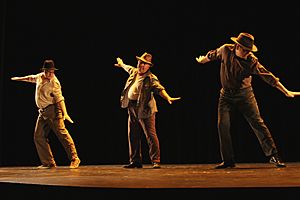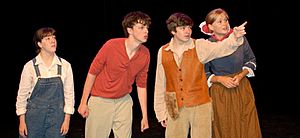Minnesota Fringe Festival facts for kids
|
.
Current Fringe logo
|
|
| Location | Minneapolis, Minnesota |
|---|---|
| Founded | 1994 |
| Founded by | Bob McFadden |
| Artistic director | Dawn Bentley |
| Selector | Unjuried |
| Type of play(s) | Comedy, drama, dance, musical, something different |
| Festival date | August 4–14, 2022 (varies by year, see here for all past dates) |
The Minnesota Fringe Festival is a big performing arts event held every summer in Minneapolis, Minnesota, United States. It usually takes place during the first two weeks of August. This exciting eleven-day festival showcases many different kinds of performing artists. It is one of many Fringe Festivals across North America.
The Minnesota Fringe is special because it is the largest "nonjuried" festival in the United States. This means performers are chosen by a lottery, not by judges. It is also the third-largest Fringe festival in North America. For example, in 2013, the festival ran from August 1–11. It featured 176 shows and had 895 performances. Over 50,000 tickets were sold during those eleven days. In 2007, attendance was affected when the I-35W Mississippi River bridge collapsed just before the festival started.
Fringe shows are usually 60 minutes long or less. Each show performs five times over the festival's eleven days. The festival provides official venues for these performances. These venues are different sizes, holding from 55 to over 400 people. They include various stage types like black-box, proscenium, or arena stages. Past venues included the Minneapolis Theatre Garage and the University of Minnesota's Rarig Center. Typically, about eleven shows share one venue.
Performing groups that join the Fringe pay an application fee. They also share the money from ticket sales with the festival. Currently, artists receive 65 percent of the ticket revenue. Dawn Bentley became the executive director of the festival on April 3, 2017. The festival took place from August 4–14, 2022. The Minnesota Fringe Festival is a founding member of the United States Association of Fringe Festivals (USAFF).
Contents
History of the Festival
The Minnesota Fringe Festival started as part of a new trend of fringe festivals in the United States. The first fringe festival in the country was the Seattle Fringe Festival, which began in 1991. After that, the Orlando International Fringe Theater Festival and the San Francisco Fringe Festival started in 1992 and 1993.
How the Festival Began
Bob McFadden founded the Minnesota Fringe Festival. It started with a budget of about $35,000. The first festival ran from June 23–July 2, 1994. Shows were held in several theaters around the West Bank area of Minneapolis. Even though it was called "Fringe," it wasn't connected to a larger, more traditional theater event.
The first festival was quickly put together and not widely advertised. It had 53 shows, and each ticket cost six dollars or less. Shows were under 90 minutes long. About 4,600 people attended, and performers came from North America, Asia, and Europe.
Growing Over the Years
The festival grew slowly in its first few years. In 1997, after a year with low attendance, the event moved to the Loring Park neighborhood. That year, 4,300 people attended. After this, Dean Seal took over from Bob McFadden as the executive director.
In 1998, the festival started offering passes for multiple shows. Attendance then increased to 6,573 people. The next year, attendance more than doubled. Festival officials said this was because of better marketing and more shows. In 2000, the Fringe received a $10,000 grant from the McKnight Foundation. It expanded again to 80 shows.
The festival's operations, with a budget of $260,000, were run from an office in Minneapolis. The festival also began to attract different sponsors. In its early years, acts were invited to perform. But by 2000, the festival used a "unjuried first-come, first-served" system. The 2001 festival was the first time organizers had to turn away applicants. The number of shows was limited to 120. The festival also started showing films and visual art as part of the Visual Fringe.
New Leadership and Expansion
Dean Seal, who was the only full-time Fringe employee, left his role in 2001. Leah Cooper, who had been the board president, replaced him. Early in her time as director, Cooper hired more staff. The 2002 festival was the first in years to use venues outside of Loring Park. It expanded into the Uptown district. By this time, the Minnesota Fringe was the largest fringe festival in the United States.
In the following years, the most popular shows at the festival saw more people attending. Many shows sold out, and some were even performed again at other venues. However, overall attendance at smaller shows decreased. Cooper planned to leave the Fringe after the 2005 festival. But she stayed an extra year to help with fundraising issues. In 2006, the festival started using venues in the West Bank neighborhood again.
Robin Gillette became the executive director for the 2007 festival. On August 1 of that year, the I-35W Mississippi River bridge collapsed. The festival was set to begin the next day. The bridge connected people to neighborhoods where performances were happening. Because of the bridge collapse, attendance was 17% lower than the year before. This was the lowest attendance since 2002. The 2008 festival had more dance shows. Ticket sales also started to recover. By 2009, the festival set a new attendance record of over 46,000 people.
Jeff Larson, who had worked as the Fringe's technical director and then associate director, became executive director in 2013. He left the position in 2016. In April 2020, the festival's executive director, Dawn Bentley, announced that the 2020 festival was canceled. This was due to the coronavirus pandemic. The organization had to refund $40,000 in deposits from artists.
What Makes Minnesota Fringe Special
No Judges for Entry
The Minnesota Fringe Festival is "nonjuried." This means that performers and shows are not chosen by a panel of judges beforehand. Companies that want to perform submit applications. Then, they are chosen by a lottery system. This lottery system started in 2004. Before that, it was "first come, first served."
Types of Performances
The festival welcomes all kinds of performing artists. Common show types include comedy (both scripted and improv), drama, and different styles of dance. There are also puppet shows, musical theater, opera, and shows for children and teens. Storytelling is also a popular category. The Minnesota Fringe, like many fringe festivals, is a great place for new and original works to be shown for the first time.
Making Shows Accessible
Every venue at the festival is accessible for wheelchairs. The festival also offers shows with ASL (American Sign Language) interpreters for people who are deaf or hard-of-hearing. There are also audio-described shows for people who are blind.
"Bring Your Own Venue" Option
In the past, the Minnesota Fringe offered a "Bring Your Own Venue" (BYOV) option. This allowed companies to perform in unique places outside the official festival venues. The BYOV option was only for shows that couldn't fit into a regular theater space. Past BYOV shows have been held in places like a clothing store dressing room, a swimming pool, an art gallery, and a coffee shop. In 2006, a record 23 shows used the BYOV option.
Festival Website
The Minnesota Fringe Festival Website is active all year. Audience members can register on the site to review any show from the yearly festival. Shows are rated from 0 to 5 stars, and people can write reviews. Each show gets an overall star rating based on the average of all reviews. The Minnesota Fringe also has photographers who take pictures at shows. These photos are used for the festival's daily slide show. In 2013, the website received over a million page views during the six-week festival period.
Festival Statistics



